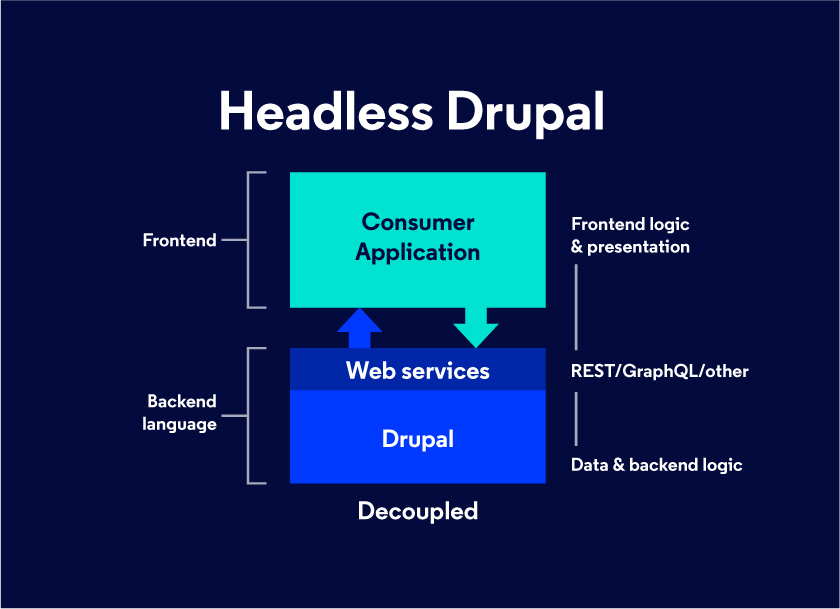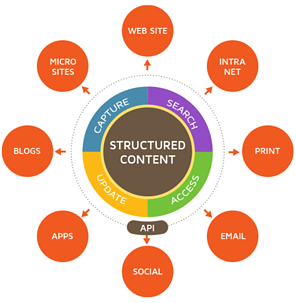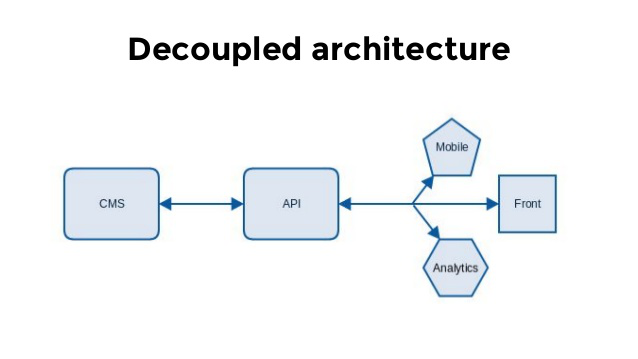Headless Versus Decoupled concept in Drupal
The concept of decoupled Drupal and headless Drupal is becoming more and more popular within the Drupal community. Some argue that a headless Drupal CMS architecture is better for everyone, while others believe that the traditional CMS architecture is much less cumbersome. Companies using Drupal are now looking for the agility and flexibility that decoupled and headless Drupal solutions offer. Hence the need to redefine your digital properties. It's important to know the difference between decoupled and headless Drupal architectures, the pros and cons of each, and when headless Drupal is the right choice for you. Choosing the best structure for your organization will ensure that you not only get what you want, but also what's best for your entire team - editors, developers, designers, and marketers. In the following paragraphs, we will try to provide some ideas on the difference between these two Drupal concepts, and then you will have a good idea of what architecture to set up for your future web project.
Benefits of the Drupal Headless concept
Compared to a decoupled system, headless Drupal offers more flexibility, agility, and performance. Because it delivers content through an API, Drupal headless can deliver your content to any device: an iOS or Android app, a kiosk, or a virtual reality (VR) headset.
With a Drupal headless architecture, your developers can also innovate, i.e., change the front-end without touching the back-end, saving your team time and money. In addition, your teams can work independently while creating content for a robust product. They can build products for multiple platforms while drawing from a single repository.
Furthermore, going headless is also a great security measure that minimizes the risks of distributed denial-of-service (DDoS) attacks and malware threats.
Note that sometimes a company needs to create multiple websites which are separate (eg. one for each brand, event, promotion, country), but which will share a lot of content. In such a case, it might be easier to create one content engine (Drupal) which will deliver content to all the microsites. The microsites can be quickly created and closed whenever a need arises and the content can be contained in one content hub.
The bigger the system one builds on Drupal, the greater the reliance on it. Abstracting Drupal from serving the frontend, allows companies to be more dynamic in changing the frontend technologies, without having to rebuild or re-architect huge Drupal backends.
Many websites, which have to maintain a fresh, modern look undergo a re-design every few years. If the frontend is separated from the backend it is much easier to rebuild. In such cases, the overall cost of the website might turn out to be lower than if the Drupal website was being rebuilt.

Benefits of the decoupled Drupal concept
In this architecture, the presentation and code layers are detached, and decoupled Drupal offers some notable advantages. Content creators can access easily configured pre-built templates for each unique channel when working on this type of architecture.
For companies with limited front-end resources, this makes it the best option, as Drupal technology support reduces the dependence on front-end engineers or designers to deliver content to different distribution channels. In this case, the CMS provides content creators with ready-made templates and easy-to-use tools to create and publish content.
A decoupled architecture allows each component to perform its tasks independently by separating the frontend from the backend, making their functionality more autonomous.
With this type of architecture we can benefit from :
1. Publish Reusable Content On Multiple Platforms
Content is expensive to create, hence it’s best to follow a structured content authoring approach (treating each content piece as a separate entity that can be independently updated and can be referenced at multiple places).
Decoupled architecture creates a technical abstract between content management and the website backend. It publishes reusable content that is easier to share on a different channel maintains and is not hard-wired to the website design.

2. Every Medium Uses the Same APIs
Following the decoupled approach, information is made available to every possible medium with the use of APIs for ingesting content from the website. There’s equal importance given to all channels as each channel uses the same API and no medium is considered to be a second-tier audience. This also means quick and easy content updates, and customization irrespective of any channel with a more efficient collaboration.
3. Exceptional Performance Delivered
With a decoupled CMS, you are allowed more flexibility and efficiency in the Drupal content model. When it comes to performance, decoupled Drupal performs well any day and proves to be better than the monolithic approach. With a client-side framework on the presentation layer, instead of Drupal’s, the user’s request to the server time reduces. This improves the user experience as the user gets a quick response to his/her query each time.
4. Impeccable Innovations
Decoupling and the latest technology go hand in hand, and you must know that the latest technology means more innovations. Decoupled Drupal architecture can aid you in implementing frameworks that are top-of-the-line. Be it Angular.js, Backbone.js, Meteor.js, Node.js, or Ember.js, you can work with any of these.

Decoupled Drupal Versus headless Drupal?
The concepts "decoupled Drupal" and "headless Drupal" are used interchangeably, although there is a significant difference in their architecture. It is true that a decoupled Drupal separates the two layers of a website via an API and hosts them independently. The API passes the content from the back-end to the front-end.
Even though the front-end and back-end areas are detached, the front-end Drupal architecture is still predetermined due to a particular environment like React or React Native. That means the two systems are still interconnected.
Drupal headless is a subset of a decoupled system, but the key difference is that a Drupal headless is truly clean at the front-end, meaning that headless has no defined presentation layer. A headless system allows you to deliver your raw content anywhere, from handheld devices to mobile apps to billboards to kiosks.
Another way to understand the difference between Drupal headless and decoupled platforms is to extend the metaphor of “a headless body.” With a decoupled architecture, the “head” is not attached to the main “body” as it is with a traditional Drupal, but the “head” is still there, and the CMS has front-end delivery tools if you want to use them.
Consider this: Unlike a headless Drupal, the decoupled system comes with a "head," but it's not necessarily mandatory to use that head. While a headless Drupal takes no responsibility for displaying content, a decoupled Drupal prepares the content for presentation and pushes it to the application's front end.
Drupal headless does what the CMS normally does without a preconceived idea of how the content will be used and without a standalone application for web browser use. Drupal headless is focused on APIs, the cloud, and IT.
The trade-off between Drupal headless and decoupled is that the application layer of the CMS is absent in the headless option. With headless, content becomes a service (CaaS), and the familiar standalone applications that allowed content creation by non-technical users, if desired, must be integrated via an API.
This leaves the horizon wide open for the adoption of a headless application stack, but it also puts developers in the driver's seat, leaving business users with no way to create content independently.
If after reading this article you feel deep down that you need to redefine the architecture of your application or website do not hesitate to contact me here for a quick quote.

